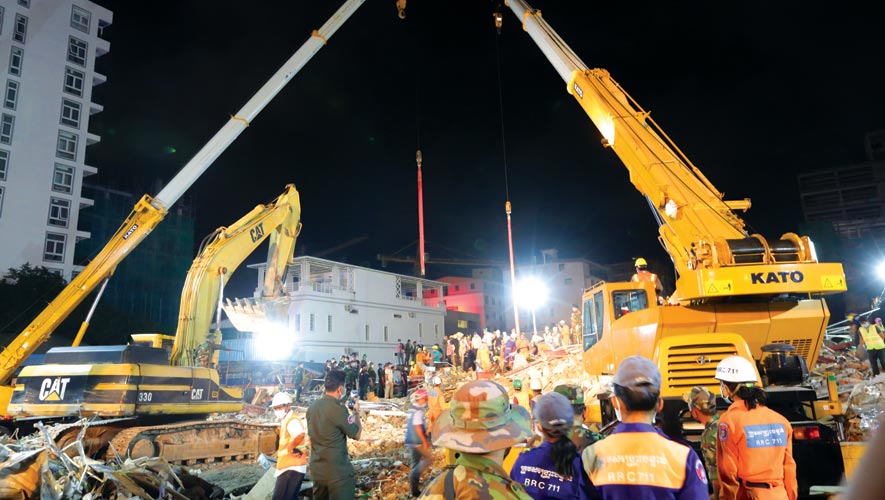The collapse of an under-construction five-storey hotel building which was unilaterally increased to seven stories, is a wake-up call. The death of 28 people could have been avoided if basic building codes had been followed, adequate accommodations had been arranged for the workers, who lived on the completed floors as construction progressed around them. The whole thing is appallable.
For the latest Cambodian Business news, visit Khmer Times Business
That the governor resigned in shame is too little too late as he was the man in charge of a province where there is intense construction infrastructure activities and which had gained world recognition, albeit for the wrong reasons.
The government’s tradition of publicly removing, terminating or admonishing officials in the face of disaster or malfeasance may have been acceptable in the past but should no longer be tolerated by the government and the Prime Minister.
They should be removed from public office and not put to pasture in another position. As long as this tradition continues, public accountability will not take place and the public’s confidence in the institutions and government may be eroded over time.
The death toll fortunately stood at 28 but this was 28 deaths too many. Imagine the consequences if it was a 20 or 30-storey building that collapsed or onto neighbouring buildings? What happens if the building was completed and occupied, like a hotel?
The scenario is unimaginable, even in nightmares. We read about such building and infrastructure tragedies elsewhere. But when it happens in our own backyard, and when the official casually remarks that two warnings had been issued but the contractor did not pay heed is deplorable.
Why didn’t they crackdown on the works and force work to come a standstill until all building regulations are complied with?
Why were the workers allowed to reside inside the unfinished building, and why was there a truck on top of the building, as some photos show? Was the structure even fundamentally safe? Did the building have building permits? Were the technical drawings sound to take into consideration dead weight and live weight situations?
Was the correct formula for concrete strength used, and did the concrete undergo random lab test to verify its strength integrity? These and many more questions remain unanswered, especially if claims that the building did not have any foundation or earth works at all, is proven to be true.
There are many causes for the collapse of construction buildings such as poor designs, incorrect or inadequate soil investi-
gation reports and type of design adopted to suit the soil conditions, eccentricity of the columns, piles, use of grade of concrete with proper vibration, the type of reinforcement with brittleness, lack of proper lapping at columns and beams and also improper spacing of stirrups as per Is codes, inadequate setting time of concrete, expedited removal of stripping time of staging and shuttering of beams, loading time over columns as well as improper curing. Any building owner, irrespective of nationality, avoids hiring an independent structural engineer, a certified project architect and relying on layman contractors who avoid safety norms such as adherence to norms, leads to disasters.
So what can we learn from this? The first step, besides the investigations into the reasons of the deadly collapse in Sihanoukville is for the Ministry of Land Management Urban Planning and Construction (MLMUPC) to pore through all approved building permits for any building which is made of concrete and or steel, and is multi-storey in nature, to verify all of the above and quickly address inadequacies if any are found. When covering this tragedy, albeit from the capital, it brings to mind the collapse of the Hotel New World in Singapore in 1986 at around 11.25 am. The collapse, which lasted less than a minute, did not leave a single wall or column standing and reduced the entire building to rubble.
According to literature in Singapore’s national library board and Singapore infopedia, a commission of inquiry was established under presidential orders to investigate the cause of the collapse. In the final report released in 1987, the panel concluded that the collapse was due to the inadequate structural design of the building. The problem was further exacerbated by new installations on the roof, and the appearance of persistent cracks in columns, walls and floors weeks before the collapse. The commission also discovered that the building’s architectural plans and structural drawings were drawn up by unqualified draughtsmen.
The documents further stressed the panel recommended that the government assumed a more active role in the building industry to avert potential disasters of this nature. Measures recommended include conducting more spot checks on buildings and legislation to enforce maintenance checks every five years. The revised laws also encouraged building owners to adopt more stringent standards in reviewing building plans, testing structural materials and supervising structural works.
These lessons and results would be a good place to start when investigating the collapse of the building.




